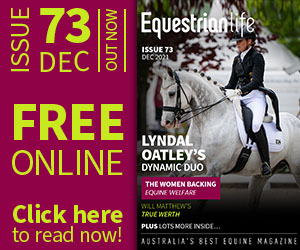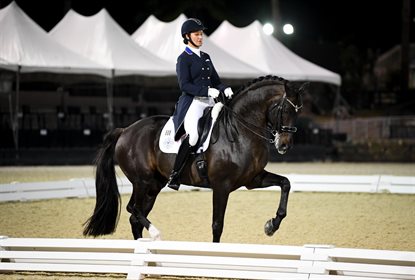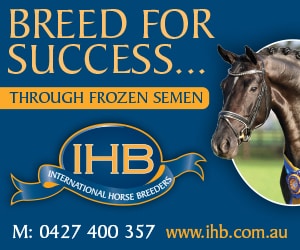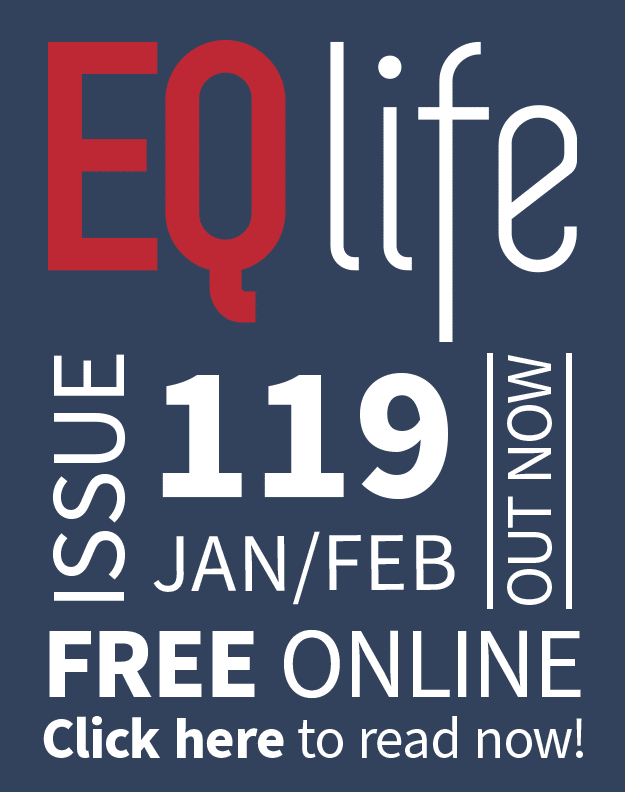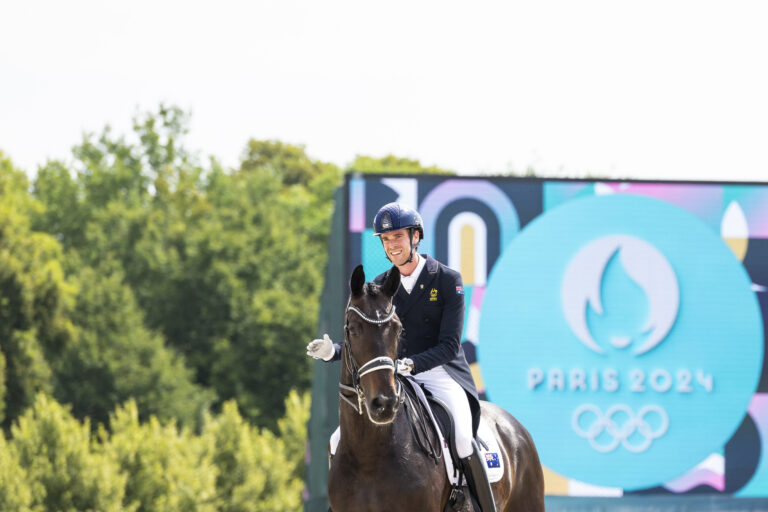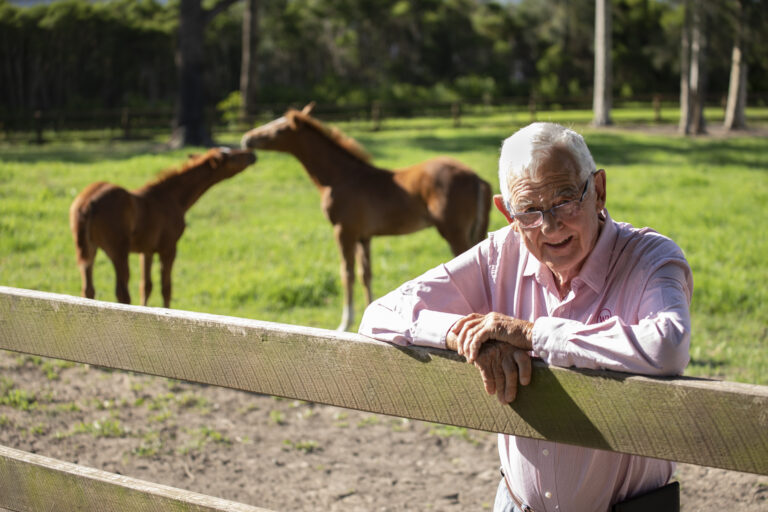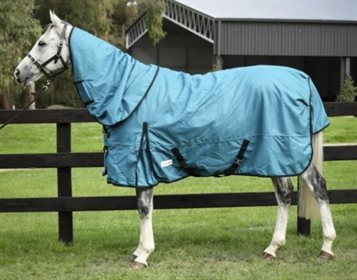This article first appeared in Equestrian Life Issue 15. To see what’s in the current digital issue click here.
Adrienne Lyle and Salvino recently scored over 80% in the Grand Prix and have been named as part of the US Dressage team for Tokyo.
© Taylor Pence/US Equestrian
It is the aim of every competitive rider to be able to translate all that hard training work into top scores. Leading Australian Grand Prix rider and top breeder, Dr Kerry Mack, shares some invaluable knowledge by looking at executing the fundamentals and all-important circles.
By Dr Kerry Mack
Most of our time as competitive riders is spent on training our horses, as opposed to actual time spent competing. This training can either be a repetition of what we have always done or we can diligently aim to try and improve on that work all the time.
I find that what keeps riding interesting year after year is the training and finding better ways to explain to the horse, ways to make the work more expressive, how to preserve the basic paces of the horse and even to improve on them. We have all seen plenty of talented young horses that actually become less expressive as they go through the grades.
So, let’s look at how to train with the idea in mind that we are aiming to improve the scores. As a starting point, let’s presume that you can already perform the movements described for a 5 (sufficient) or a 6 (satisfactory), but that you want to obtain a higher mark. A 7 is fairly good, and an 8 is good. That is what we all hope to be. Of course you will not get a higher mark in the ring than the quality of the work that you are training at home, so you must have the higher goal in mind in the training.
Did you watch the last Olympics or WEG? The most striking thing about the top tests with the scores of 8 was the energy in the paces and the horse’s ability to stay balanced with that amount of energy in the movements and in the transitions between movements. If a movement is performed accurately and correctly the mark will reflect the quality of the pace within the movement and the balance. So, once a movement is understood and correctly executed you can start to work to improve it.
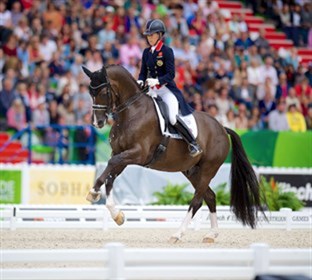
Charlotte Dujardin and Valegro showing plenty of expression…. and probably scoring more than an 8!
© FEI/Arnd Bronkhorst/Pool Pic
When you are starting to train a new movement, do not make it too complicated for your horse by insisting on expression as well. Just be content with an approximation of what you want and keep rewarding better attempts. As the horse gets more confident, you can ask for more expression and cadence.
Essentially, expression is the height of the steps and cadence is a combination of expression and rhythm. Expression is a result of the horse reacting to your leg to make a higher more energetic step, rather than a longer more energetic step – or worse, a faster more energetic step. The horse must maintain the correctness of the movement and maintain the correct balance, with more energy. The energy comes from the horse’s response to your leg. The response to the leg must be quick. The leg must be applied quickly and the horse must keep the energy without continually being reminded or nagged with the leg. Leg on, response, leg off, keep going. Allow him to make a little mistake and slow down and be quick to correct him with the leg, so he learns to not slow down when the leg is off. He must only slow down when he is asked with the rein or the seat/back. Remember that you can only collect whatever energy you have in the first place.
So, let’s look at circles as the first example, as circles are frequently required up to Prix St Georges. A well executed circle is a thing of beauty, demonstrating the horse’s suppleness and athleticism. The circles of course get smaller as the levels go up and the requirement for collection and a higher frame increase. Make sure you know the appropriate landmarks for the size circle you need to do. Always prepare your circle before you get to the marker where it starts. In training, start by getting the best trot you can. Put in the energy with your leg, determine the rhythm with your seat, ensuring that even at sitting trot you are on the correct diagonal so that the aids are timed correctly to influence the inside hind leg to push. When you sit a tiny bit heavier, as the inside hind leg pushes you, leg aid will be timed correctly, and as your seat is a tiny bit lighter as this diagonal pair (inside hind leg and outside front leg) are moving forward, you encourage a little more reach forward.
Get your best energetic trot and make a large circle. Keep the energy and allow the horse to find the balance in it. Find the opportunity to relax your hand to ensure that the horse is in self carriage and insist that he keep the energy (expression and cadence). Ride from the back to the front – that is, leg into a soft hand.
As the horse finds balance more easily, just make the circle a little smaller – say 18 meters. Keep the energy expression and balance. Your leg re- minds the horse to stay energetic. Give the rein a little to test self-carriage. His body must remain vertical, not leaning in. The hind legs must follow the front legs so he is straight (with bend). He must have appropriate bend. Do not allow him to make slower or shorter steps. Try to make each step the same all the way around the circle. When the horse finds its balance, make the circle smaller, to 15 meters.
Keep doing this until you find the horse’s current limit. You have found the limit when the horse pushes down on your hands to balance, or it can’t keep its rhythm, leans in, swings his quarters in or bulges his shoulders out and you can no longer correct these evasions. When the horse can’t find a way to keep its balance and impulsion together, you must allow the circle a little bigger and insist on quality. With systematic train- ing the horse will learn to keep its balance in a smaller and smaller circle and become more advanced. Remember that you cannot force the horse to find this balance. He must balance and be in self-carriage. Don’t allow him to balance on the rein. Be patient and have integrity.
One of the most important movements to train for an 8 is the halt. Every test has at least two. The entry must be straight. Practise going up the centre line with your best expressive trot. Steady over the X and keep going. Practise halting on the wall and all over the arena. Balance the trot. As you use the reins, the neck must not shorten. His head must just travel forward in space smoothly. As you half halt with your back don’t bear down too hard. His hind legs must step up under your seat, and his back comes up as his pelvis rotates a little. This won’t happen if you sit down too hard and push his back down. He must step up and forwards into the halt. Stay still only as long as he is prepared to do at the beginning, go forward and straight, look up, and repeat it until he knows to wait. The halt must be straight. Always correct straightness by moving the shoulder across to be in front of the hind leg. The depart must be straight and immediately into trot. No walk steps. It may seem easy, but if you don’t ask you wont get it. Always halt at X at the end of a work session, so he learns that X is a bit like home base and thus is conditioned to relax at X.

Training the halt.
© Roger Fitzhardinge
The principles of keeping the energy in the pace with rhythm, continually improving the balance with transitions and ensuring straightness, and bend when needed will see your marks improve. I will tell you more about training the other movements later. You will find it is really interesting to see what your horse is capable of and to see how it improves if you are diligent about rhythm, energy, balance and self-carriage. And, you will find the score improves.
READ THE LATEST NEWS ARTICLES HERE
